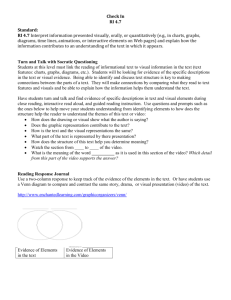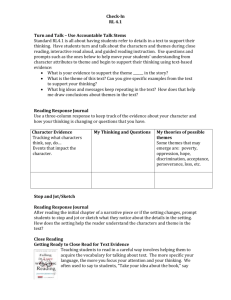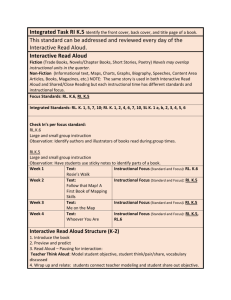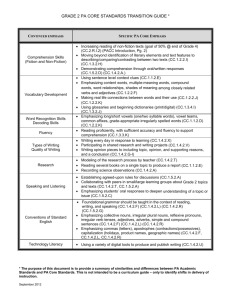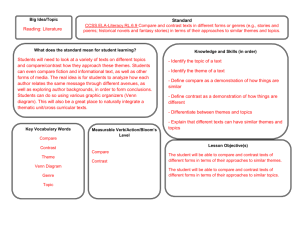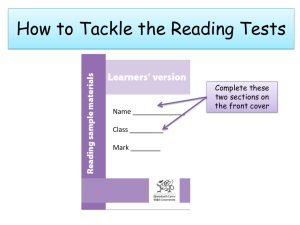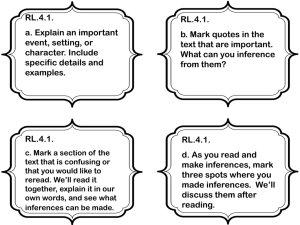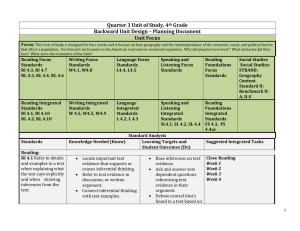Check In RL 4.6
advertisement
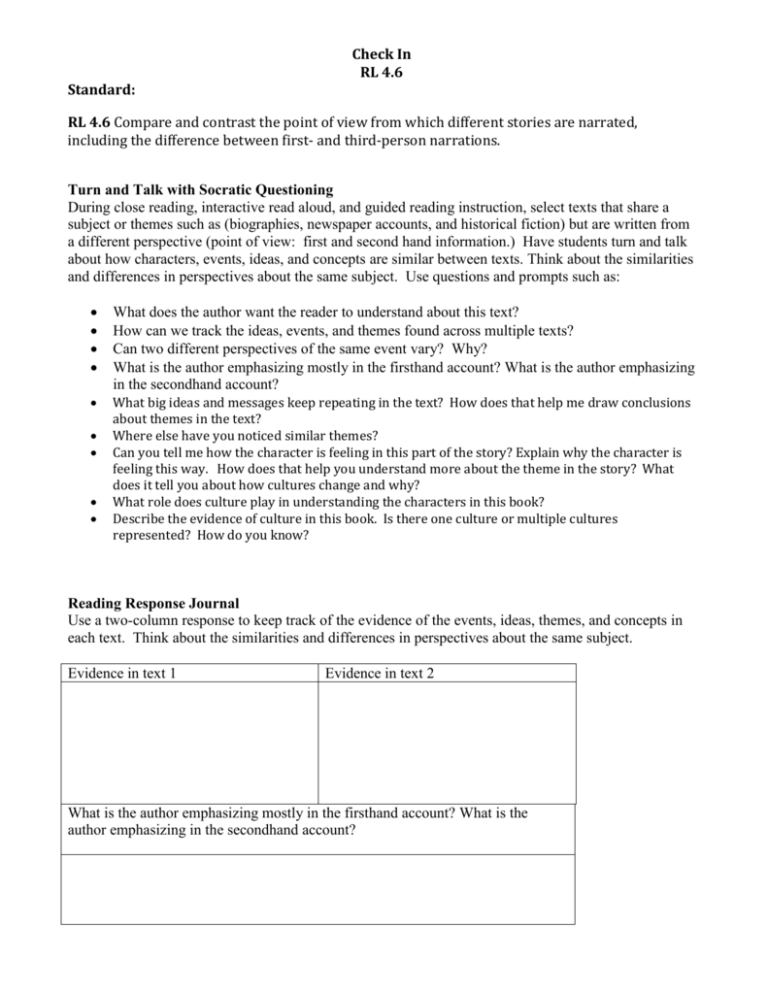
Standard: Check In RL 4.6 RL 4.6 Compare and contrast the point of view from which different stories are narrated, including the difference between first- and third-person narrations. Turn and Talk with Socratic Questioning During close reading, interactive read aloud, and guided reading instruction, select texts that share a subject or themes such as (biographies, newspaper accounts, and historical fiction) but are written from a different perspective (point of view: first and second hand information.) Have students turn and talk about how characters, events, ideas, and concepts are similar between texts. Think about the similarities and differences in perspectives about the same subject. Use questions and prompts such as: What does the author want the reader to understand about this text? How can we track the ideas, events, and themes found across multiple texts? Can two different perspectives of the same event vary? Why? What is the author emphasizing mostly in the firsthand account? What is the author emphasizing in the secondhand account? What big ideas and messages keep repeating in the text? How does that help me draw conclusions about themes in the text? Where else have you noticed similar themes? Can you tell me how the character is feeling in this part of the story? Explain why the character is feeling this way. How does that help you understand more about the theme in the story? What does it tell you about how cultures change and why? What role does culture play in understanding the characters in this book? Describe the evidence of culture in this book. Is there one culture or multiple cultures represented? How do you know? Reading Response Journal Use a two-column response to keep track of the evidence of the events, ideas, themes, and concepts in each text. Think about the similarities and differences in perspectives about the same subject. Evidence in text 1 Evidence in text 2 What is the author emphasizing mostly in the firsthand account? What is the author emphasizing in the secondhand account? Check In RL 4.6 Stop and Jot Interactive Read Aloud Strategy Reading Response Journal After identifying the structure of a piece have students stop and label evidence in the document that provide clues to the credibility of the source. For example, is it a first person account? Does the author use I, we, and myself when describing an event? Does the text include any credible evidence such as dates, letterhead, symbols, or photographs? Provide opportunities in the reading to stop and jot their thinking about how they are using the structure to help them better understand the text. Close Reading using Informational Evidence Lens Lesson Plan Example: Week 4 Transcontinental Railroad Video – Westward Expansion http://www.history.com/topics/westward-expansion Students will also need access to close reading passages from weeks 1-3. Week English Spanish Week 1 Becoming a Melting Pot Una mezcla de culturas Week 2 The Growing US pages 2-5 Los Estados Unidos Crecen pages 2-5 Week 3 For Purple Mountains Majesties Instructional Focus (Standard and Focus): RI 4.4, L4.4a-c Academic Vocabulary in context. Use reference material to confirm word meaning. Instructional Focus (Standard and Focus): RI 4.1, SL 4.2 Referring to details and examples in text, paraphrase portions of text read aloud or media sources. Instructional Focus (Standard and Focus): RI 4.7 Interpreting Information Instructional Focus (Standard and Focus): W4.1 RI 4.7 Opinion Writing How does the information contribute to the understanding of the text Introduce Text Vocabulary Development Close Reading 1. Read through a lens. Identify Genre: Text Structure: Read Aloud and scaffold vocabulary. (Intentionally plan this lesson based on the Language Standards and Vocabulary, student needs and the text you’ve selected.) Vocabulary in the Replay the video looking for Close Reading 2.Look For Patterns 3.Developing a new understanding Replay video Look for Patterns In small groups reread the passage and the evidence from yesterday. Have students work in pairs and find which pieces of evidence fit together. Assessment Narrative or Expository Writing Task Teacher will pose an open-ended question for students to respond to in written form. Role of Transcontinental Railroad in Growth of the West. Have students highlight text evidence. Chart student responses in the Chart the patterns you find in the second column of your anchor chart. Developing a new This may be an opportunity to encourage students to respond using technology. Students will work on this task Instructional Focus (Standard and Focus): W4.8, W4.9 Gathering relevant information in the text. Explain how authors use reasons to support text. Assessment Narrative or Expository Writing Task Model how to use the PARCC Literary Response Rubric so students can assess their writing with a partner. Model identifying 1 or 2 areas that students could improve in their response based Check In RL 4.6 video: Make a list Replay video looking for clues for meaning of words. KIM See reference below. Key Info Me wor rma mo d tion ry Clu e Confirm meaning using reference materials. first column of an anchor chart. understanding Review anchor chart evidence and patterns. Turn and Talk about noticing’s. Oral Synthesis in small groups: Statement using sentence frame: – First I was thinking ______ now I am thinking _____ because…. Share out students Synthesis with whole group. independently, using evidence from the text. Open Ended Question: Compare the video and 1 of your close reading texts from this unit. Provide examples of how the geography affected the growth of the west. on the rubric. Have students get in groups of four and share their Open Ended Responses to the prompt. Students will provide 1-2 things the writer could do to improve their response. Students should spend 10 minutes revising their responses to the open-ended question based on the feedback they received. Share 2-3 revised responses with the whole class.
